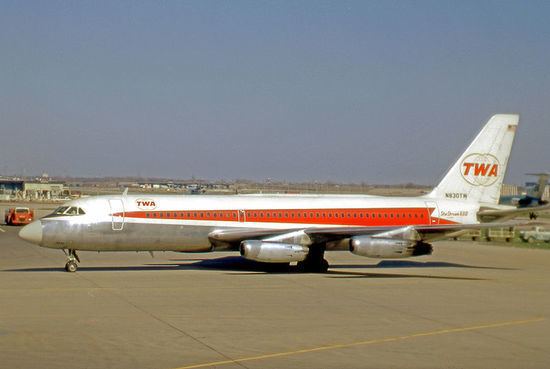Top speed 966 km/h Wingspan 37 m Engine type General Electric CJ805 First flight January 27, 1959 | Cruise speed 990 km/h Length 39 m | |
 | ||
Delta airlines convair 880 jet aircraft 1960s promotional film 78564
The Convair 880 was a narrow-body jet airliner produced by the Convair division of General Dynamics. It was designed to compete with the Boeing 707 and Douglas DC-8 by being smaller and faster, a niche that failed to create demand. When it was first introduced some aviation circles claimed that at 615 mph (990 km/h) it was the fastest jet transport in the world. Only 65 Convair 880s were produced over the lifetime of the production run from 1959 to 1962, and General Dynamics eventually withdrew from the airliner market after considering the 880 project a failure. The Convair 990 was a stretched and faster variant of the 880.
Contents
- Delta airlines convair 880 jet aircraft 1960s promotional film 78564
- Convair 880 lisa marie the history tour 1960 2015
- Design and development
- Operational history
- Civil operators
- Military operators
- Accidents and incidents
- Survivors
- Specifications 880 Model 22 22 M
- References

Convair 880 lisa marie the history tour 1960 2015
Design and development

Convair began development of a medium-range commercial jet in April 1956, to compete with announced products from Boeing and Douglas. Initially the design was called the Skylark but the name was later changed to the Golden Arrow, then Convair 600 and then finally the 880, both numbers referring to its top speed of 600 mph (970 km/h) or 880 ft/s (268 m/s). It was powered by General Electric CJ-805-3 turbojets, a civilian version of the J79 which powered the Lockheed F-104 Starfighter, McDonnell Douglas F-4 Phantom and Convair B-58 Hustler.

The first example of the initial production version, the Model 22, made its maiden flight on January 27, 1959. There was no prototype. After production started the FAA mandated additional instrumentation, which Convair added by placing a "raceway" hump on the top of the fuselage, rather than ripping apart the interiors over the wing area. The final assembly of the 880 and 990 took place at the Convair facilities in San Diego, California.
The airliner never became widely used and the production line shut down after only three years. The 880's five-abreast seating made it unattractive to airlines, while Boeing was able to out-compete it with the Boeing 720, which could be sold much more cheaply as it was a minimal modification of the existing 707. In addition, the General Electric engines had a higher specific fuel consumption than the Boeing's Pratt & Whitney JT3Cs.
General Dynamics lost around $185 million over the lifetime of the project, although some sources estimate much higher losses. It is generally agreed that the losses incurred in the Convair 880/990 were the largest losses incurred by a corporation up to that time. The aircraft were involved in 17 accidents and five hijackings.
A modified version of the basic 880 was the "-M" version which incorporated four leading edge slats per wing, Krueger leading edge flaps between the fuselage and inboard engines, power-boosted rudder, added engine thrust, increased fuel capacity, stronger landing gear, greater adjustment to seating pitch and a simpler over-head compartment arrangement.
A more major modification to the 880 became the Convair 990, produced in parallel with the 880-M between 1961 and 1963. Swissair named theirs Coronado, after an island off the San Diego coast and where the first 990 landed, despite Convair's flying boat with that name.
Operational history
The design entered service with Delta Air Lines in May 1960, slightly modified as the 880-22m, having newer version 805-3B engines. 880s were flown by Cathay Pacific, Delta, Japan, Northeast, Swissair, TWA and VIASA.
As they left commercial service, many 880s were bought by American Jet Industries for various uses. One example was converted to freighter use in 1974, and flew until 1982 with various companies. Another was used to train FAA flight examiners until it was destroyed by a minor explosion in the cargo hold in 1995. Most of the remaining examples were scrapped by 2000.
The United States Navy acquired one 880-M in 1980 modifying it as an in-flight tanker. It had been purchased new from Convair by the FAA, and used for eighteen years. Unofficially designated UC-880, it was assigned to the Naval Air Test Center at NAS Patuxent River, Maryland and employed in Tomahawk Cruise Missile testing and aircraft refueling procedures. Convair designed and manufactured the Tomahawk and Advanced Tomahawk Cruise Missile in San Diego where the 880 and 990 were produced. The sole UC-880 was damaged in a cargo hold explosive decompression test at NAS Patuxent River, Maryland in 1995. The aircraft managed to remain theoretically controllable via backup systems unique to the 880 & 990.
Civil operators
(♠ = original operators)
Military operators
Accidents and incidents
Survivors
Specifications (880 Model 22 & 22-M)
Data from Jane's All The World's Aircraft 1965-66
General characteristics
Performance
